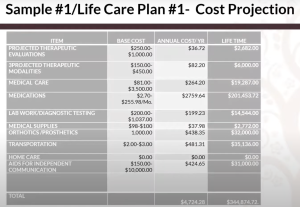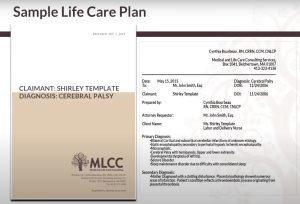When it comes to future care planning after an injury or illness, every detail matters.
A strong life care plan doesn’t just predict future needs, it builds a comprehensive roadmap based on where the patient is today and what they’ll need to maintain the best quality of life moving forward.
It begins with a clear picture of the present status, then transitions into treatment recommendations. Each recommendation is supported by clinical reasoning — not just a list of services, but a detailed explanation of why each service is necessary. This ensures the plan is not only useful but defensible.
At the start of every plan, a summary table outlines key recommendations based on different possible living scenarios. Will the patient remain at home with family support? Will they require residential care? What if they live independently but need full-time professional caregivers? The life care plan maps out each scenario clearly, making it easy to understand the financial and care-related implications.
From there, the plan dives deeper. Each category, whether it’s physical therapy, medical appointments, durable medical equipment, or medication needs, is broken down across a lifetime timeline.
For example, in pediatric cases, the plan accounts for how services transition when a child ages out of federally supported school systems at 22 — ensuring that no essential therapies are lost in the process.
Real-World Life Care Planning in Action
No two patients follow the same path, and the real world rarely fits neatly into templates.
In one case, a child’s life care plan carefully mapped out therapy and care needs from childhood through adulthood, planning ahead for critical transitions.
In another, a young man who suffered a devastating head injury while cycling in the United States faced an entirely different set of challenges. After initial treatment stateside, he was moved to Ireland — only to discover that rehabilitation options there were extremely limited. His family, holding dual citizenship, ultimately relocated to Germany to access better care.
This case required more than just standard planning. It involved international communication with doctors, equipment vendors, and rehabilitation facilities — across different time zones, languages, and currencies. His life care plan had to reflect services available in Germany, the costs in euros, and the evolving needs of a patient whose condition unexpectedly improved after surgery.
When his cranial plate, which had been shifting and irritating his brain, was replaced, his responsiveness began to return. What was initially a static case suddenly had potential for change — and the life care plan adapted, outlining an additional year and a half of therapies to foster further recovery.
Each case demonstrates why life care plans must be flexible, detailed, and personalized — not just one-size-fits-all templates.
Cost Projection vs. Life Care Plan: Which One Do You Need?
One of the most common questions from attorneys and case managers is whether a full life care plan is needed, or if a simpler cost projection will do.
Here’s the difference:
Cost Projection
A shorter, faster report that focuses solely on estimating future costs. It does not include detailed clinical justifications or a full narrative of the patient’s condition. This option is ideal for cases that are likely to settle rather than proceed to trial.
View a real-world example:


Life Care Plan:
A comprehensive, fully developed report that includes the patient’s current medical status, detailed clinical reasoning for each recommendation, and multiple cost scenarios to produce a defensible average. This type of plan is essential when preparing for litigation and provides a robust foundation for expert testimony.
The good news: if you start with a cost projection and later find out that a full life care plan is needed, you’re not starting over.
Thanks to custom-built software at Medical and Life Care Consulting (MLCC), projections can be expanded into full life care plans quickly and accurately, simply by adding the deeper reasoning and record summaries required for court.
How Long Does It Take to Develop a Life Care Plan?
The process is comprehensive and involves much more than just compiling a list of services — it requires organizing and analyzing extensive medical records; researching local costs for therapies, services, and equipment; and working with healthcare professionals to ensure every recommendation is grounded in clinical expertise.
For adult cases with focused injuries, the planning process typically requires 30 to 40 hours. However, pediatric cases or complex cases involving years of medical records can take 60 to 90 hours or more to complete.
To illustrate the level of detail involved, consider the sample life care plan provided below, which highlights the types of documentation and reasoning required for each patient.

Although automation tools have helped speed up certain aspects of the process, life care planning remains a meticulous task. It demands careful attention to every detail — especially when addressing long-term care needs that may evolve over time.
Last-minute requests, such as needing a comprehensive plan within two weeks, are challenging to fulfill without risking crucial details being overlooked. Ideally, life care planning should begin at least a month before any deadlines to allow for sufficient time to conduct research, arrange interviews, and draft a thorough and defensible report.
When Is the Right Time to Start a Life Care Plan?
Timing is everything.
Some attorneys wait until trial is approaching before requesting a life care plan, but that strategy can backfire.
Building a plan early — even if it needs minor updates later — puts your case in a stronger position. If the patient’s injuries are stable and long-term needs are becoming clear, it’s usually the right moment to start.
Early life care planning also supports strategic settlement discussions. Having a preliminary opinion or summary early in the case helps guide negotiations and sets clear expectations for future costs. If trial becomes necessary, the full plan can be finalized and strengthened with updated records and cost research.
Bottom line: It’s always better to be early than to be rushed.
How Medical and Life Care Consulting (MLCC) Can Help
MLCC provides a full range of services designed to support attorneys, adjusters, and case managers including:
• Medical Chronologies
• Medical Cost Projections
• Life Care Plans
• Medicare Set-Aside Allocations
At the end of the day, the real cost of care is about more than numbers — it’s about people, futures, and making sure no detail is overlooked. A strong life care plan provides the clarity needed to navigate the complex journey ahead, whether it’s through settlement negotiations or preparing for trial. With the right planning partner, you can be confident that every recommendation is grounded in clinical expertise and every future need is accounted for.






